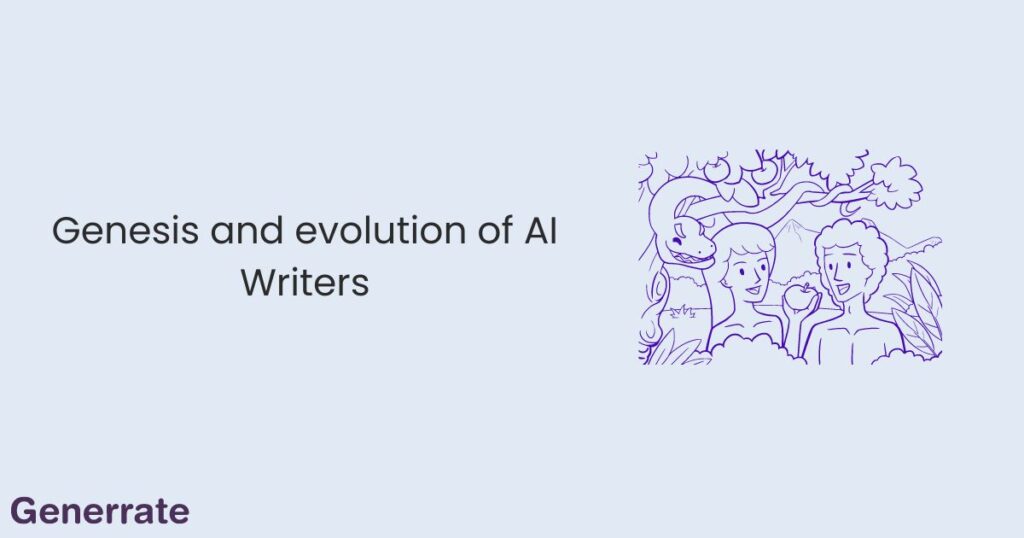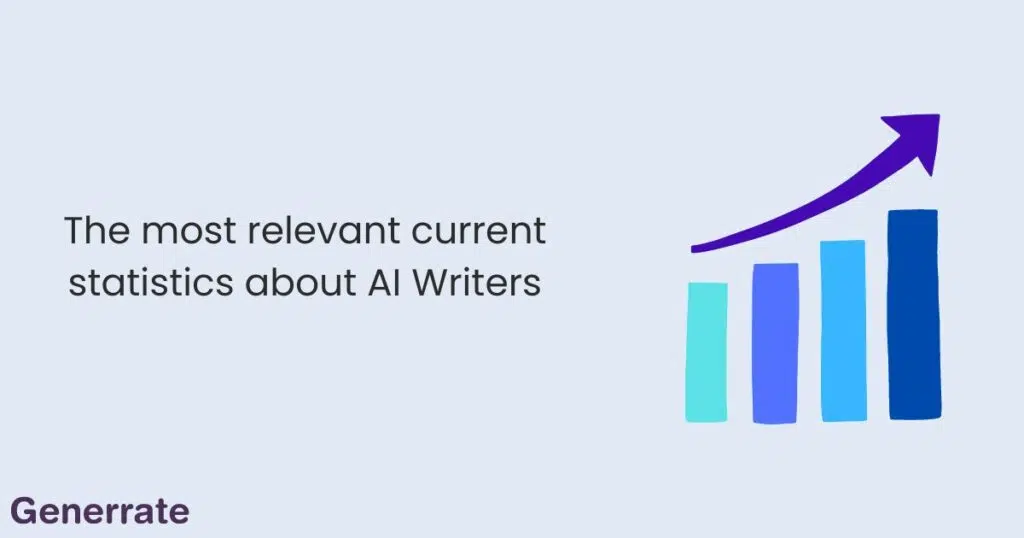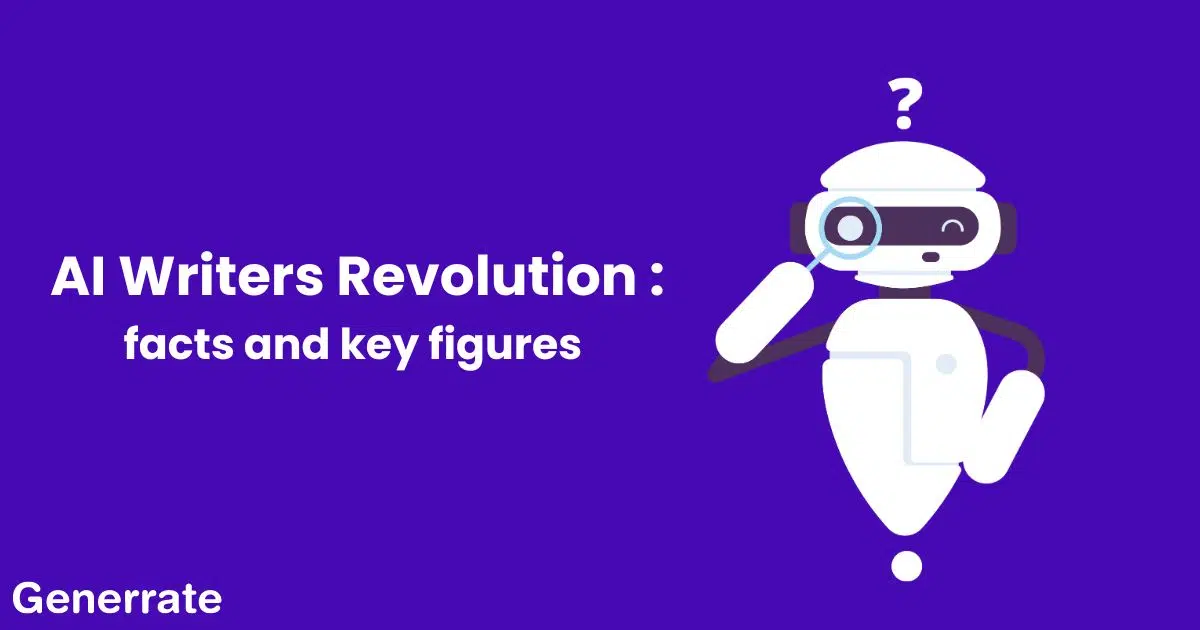AI Writers are becoming more and more important in the world of content creators, and the figures we’ll see next prove it!
Indeed, it has become almost indispensable for content creators to integrate AI into their copywriting, if not in just one stage of their content creation process. This could be the creation of content from scratch, or its subsequent review by an AI tool.
In what follows, we’ll take a look at the evolution of AI Writers over the years, as well as figures we feel are most relevant to the growing role of AI writers in the content creation process.

The Genesis of Automated Writing Tools
Automated writing tools have come a long way since their inception, which can be traced back to the early days of computer technology.
The initial phase of these tools was dominated by simple programs that focused on correcting grammar and spelling errors. These rudimentary spellcheckers operated within word processing software, like Microsoft Word, and were limited in their ability to improve the overall quality of written content. As technology advanced, so did the ambition to create more sophisticated software capable of not just proofreading but also aiding in the writing process itself.
Early attempts at automating more complex writing tasks often involved rule-based systems. These systems could generate technical documents and reports by assembling predefined phrases and sentences based on a logical structure, resembling more of a template-filling exercise than true writing.
Although their abilities were basic, these initial automated writing tools laid the groundwork for future endeavors in the field. They opened the door for thinking about writing as a process that could be enhanced or even replicated using artificial intelligence.
Advancements in Deep Learning for Text Generation
The field of automated writing underwent a significant transformation with the advent of deep learning and neural networks.
Deep learning, a subset of machine learning, utilizes multi-layered neural networks to analyze and interpret complex patterns in data. When applied to text generation, these models could learn from vast amounts of text data and begin to generate coherent and contextually relevant content.
A pivotal breakthrough came with sequence-to-sequence models, where systems like Recurrent Neural Networks (RNNs) and later, Long Short-Term Memory (LSTM) networks, showcased the ability to remember and utilize previous inputs to generate outputs that were more coherent over longer spans of text.
These successes paved the way for even more sophisticated models, such as the Transformer architecture, which changed the game by enabling parallel processing of sequence data and appreciably improving efficiency and effectiveness in learning patterns within text.
Under this umbrella came models like GPT (Generative Pretrained Transformer) and BERT (Bidirectional Encoder Representations from Transformers), which achieved unprecedented fluency and context understanding.
Emergence of AI Assistants in Professional Writing
With the maturity of deep learning models, AI writing assistants began to emerge in the professional world. These tools were a far cry from the spellcheckers of old, offering functionality that could revamp the writing landscape. AI writing assistants, like Generrate, started to incorporate more complex linguistic algorithms to enhance writing quality, addressing elements like sentence structure, style, and tone.
However, the real leap came with AI systems capable of generating content from scratch. Some of these AI writers, such as OpenAI’s GPT-3, demonstrated an ability to write creative fiction, technical articles, coding sequences, and even poetry, by simply being fed an initial prompt. Professionals began to leverage these tools not only for content creation but also for ideation, copywriting, and email composition, to the point where AI became a silent co-author in an ever-expanding array of written works.
AI Writer Capabilities and User Interaction
The capabilities of modern AI writing software are broad and continually growing. These systems can now handle a range of tasks, from generating whole articles to crafting marketing copy that aligns with a brand’s voice.
Their use has permeated into various industries including journalism, marketing, and education. From a user interaction perspective, AI writers are designed to be extremely collaborative. They offer suggestions that users can accept, modify, or reject, blending the AI’s generative capabilities with the human user’s creativity and critical thinking.
This partnership facilitates a highly iterative writing process where the user maintains control over the final product while benefiting from the AI’s assistance in generating ideas and refining content. Nevertheless, the interaction still has its challenges. Navigating bias, ensuring factual accuracy, and maintaining a unique voice are areas where human supervision is critical.
AI writers also require clear instructions and prompts to produce the desired output, which means users need a certain level of skill and understanding to effectively collaborate with these tools.
Predicting the Next Wave of AI Writing Innovations
Predicting the future of AI writing requires a look at current trends and how they might evolve. One such trend is the move towards even more personalized AI writing experiences, where AI tools adapt to the individual user’s style and preferences in more profound ways.
There is also ongoing research into improving the emotional intelligence of AI writers, allowing them to detect and express nuanced emotional undertones within text appropriately. Another area of innovation is real-time collaborative writing, where multiple individuals, alongside an AI, can to a document simultaneously.
This would further streamline the writing process and enhance creativity through immediate exchange and evolution of ideas. Improving the ethical considerations of AI-generated content is also paramount.
Ensuring that AI writing tools are unbiased and promote truthful, original content will be a critical challenge as these tools become mainstream in knowledge dissemination. Finally, as AI writers become more advanced, they might begin to challenge the boundaries of authorship.
Questions around intellectual property, particularly for content that’s wholly generated by AI, will necessitate a re-evaluation of current copyright laws and the definition of creativity. In summary, it seems clear that AI writing technology will continue to evolve, integrating deeper into the fabric of human creativity and communication, and transforming how we interact with the written word in profound ways.
The potential for AI in writing is as vast as language itself, with future innovations likely to redefine the art and science of writing as we know it.
Having described the evolution of AI Writers over time, we’ll now look at the most relevant figures for the state of AI Writers today, and how they’re evolving.

The growing awareness statistics
- With growing interest in the use of AI Writers in content creation, 68% of Marketers Believe Learning AI is Essential. Underlining a fear for customer privacy. (Source : Capterra’s Futureproof Marketing Survey)
- AI will create jobs, not destroy them. That’s what marketers believe. Indeed, 48% of surveyed marketers believe that AI will create more jobs than it will destroy. (Source : Capterra’s Futureproof Marketing Survey)
- More than 75% businesses say it is important for them to be able to trust AI’s analysis, results, and recommendations. (Source : Oberlo)
- 94% of business leaders surveyed agree that AI is critical to success over the next five years. (Source : Deloitte)
- 75% of executives fear business closure in the next five years without implementing AI. (Source : Zippia)
- Two-thirds, or 66%, believe that AI-powered products and services will bring significant changes to their daily lives in the next 3-5 years. (Source : IPSOS)
The implementation growth statistics
- The number of ChatGPT visitors in December 2023 was 1.6 billion. An increase of 500% compared with December 2022. (Source : Exploding Topics)
- The size of the worldwide Artificial Intelligence Market is projected to increase from $86.9 billion in 2022 to $407.0 billion by 2027. An increase of 368%. (Source : MarketsandMarkets Research)
- By 2030, it is anticipated that AI will contribute to a 21% net increase in the United States GDP. (Source : Statista)
- The forecast predicts a 146% surge from 2019’s 3.25 billion to 8 billion AI-powered voice assistants by 2023. (Source : Oberlo)
- Global revenue from AI chips is expected to exceed $80 billion within the next five years. (Source : THEINSIGHTPARTNERS)
- In 2025, the surging industry will require around 97 million people to meet its workforce demands. (Source : Forbes)
To sum up
In conclusion, the journey of AI Writers from inception to today has been remarkable. These tools have transformed from a novel idea to powerful entities shaping our online content experience. Current statistics underscore their significant impact on productivity, especially in AI Content Creation and AI Chatbots.
The numbers reflect a consistent rise in their usage, showcasing their effectiveness. However, it’s crucial to emphasize that AI Writers complement human creativity rather than replace it. They serve as powerful collaborators, freeing up creative potential by handling mechanical tasks.
